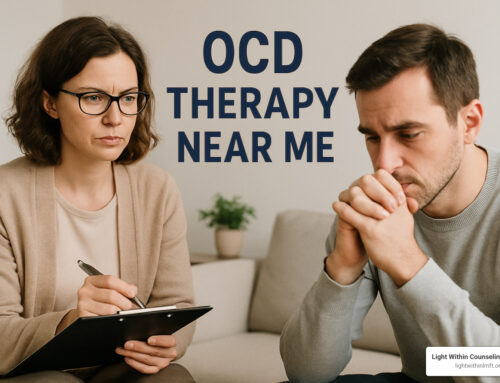What Is Sexual Orientation OCD (SO-OCD)?

Obsessive-Compulsive Disorder (OCD) can take many forms, and one of the most confusing and distressing for those who experience it is Sexual Orientation OCD, often abbreviated as SO-OCD. This subtype of OCD involves persistent, intrusive thoughts and doubts about one’s sexual orientation, which cause intense anxiety and distress.
If you’ve found yourself questioning your sexual orientation in a way that feels obsessive, fear-driven, or out of the blue—despite no previous doubts or changes in attraction—you may be dealing with SO-OCD. It’s not about genuine exploration or fluidity of identity; it’s about fear, doubt, and compulsive attempts to feel certain.
How Common Is SO-OCD?
SO-OCD is more common than many people think, though it’s often hidden due to shame and fear of judgment. Research suggests that intrusive sexual thoughts are experienced by many people with OCD, and sexual orientation-themed obsessions are a frequent presentation—especially among those with scrupulous or perfectionistic tendencies.
SO-OCD can affect people of any sexual orientation. What defines it as OCD is not the content of the thought itself, but the person’s distress about it, their compulsive efforts to gain certainty, and the fact that the thoughts are unwanted and ego-dystonic (not aligned with their actual identity or desires).
What Does SO-OCD Look Like?
SO-OCD typically includes:
- Obsessions:
- “What if I’m actually gay/straight/bi and just don’t know it?”
- “What if I’ve been lying to myself or others this whole time?”
- Unwanted sexual images or mental scenarios involving people of the same or opposite sex.
- Fear of being “outed” or suddenly realizing a different identity.
- Compulsions:
- Mentally reviewing past relationships or attractions to “prove” one’s orientation.
- Avoiding same or opposite gender people to prevent feeling “triggered.”
- Checking for arousal or physical reactions (“groinal response”).
- Seeking reassurance from friends, partners, therapists, or the internet.
- Comparing self to others or testing attraction through fantasy or pornography.
It’s important to note: SO-OCD is not about being homophobic or denying one’s true identity. It’s about the brain getting stuck in a cycle of obsessive doubt and compulsive reassurance-seeking, regardless of the actual orientation.
The Stigma of SO-OCD: Why It’s So Hard to Talk About
Just like postpartum OCD, harm OCD, POCD and other taboo-themed OCD subtypes, SO-OCD often goes undiagnosed because it’s so misunderstood, even by mental health professionals.
Why Is There So Much Stigma Around SO-OCD?
- Confusion with Identity Exploration
In today’s world, many people do explore their identity, which is healthy and normal. SO-OCD, however, is not exploration—it’s anxiety-driven obsession with certainty and fear of being “wrong.” People with SO-OCD often feel ashamed that their fears will be misinterpreted as denial or prejudice. - Fear of Judgment
Because the thoughts involve sexuality—a deeply personal and sometimes politicized topic—people fear being labeled as closeted, in denial, or even offensive. This makes it difficult to seek help or even admit the thoughts to themselves. - Shame and Internalized Pressure
Those with SO-OCD may feel embarrassed that they “can’t just be sure,” especially if they’ve never questioned their identity before. The more they try to be certain, the more uncertain they feel—a hallmark of OCD. - Misunderstanding by Professionals
Some therapists may not recognize SO-OCD and instead encourage more exploration or treat it as identity confusion. While exploration is helpful for someone genuinely questioning their identity, this approach can unintentionally fuel the OCD cycle for someone with SO-OCD.
How SO-OCD Differs from Being LGBTQ
It’s important to recognize that SO-OCD is not the same as being lesbian, gay, bisexual, queer, or questioning. People in the LGBTQ community come to understand and embrace their identity over time, often with a sense of clarity, self-acceptance, and peace—even if it’s challenging at first due to societal pressures. In contrast, someone with SO-OCD is caught in a cycle of relentless doubt, anxiety, and fear around their orientation—despite often having no genuine change in attraction.
Where LGBTQ individuals may feel relief or congruence when coming out or acknowledging their identity, individuals with SO-OCD tend to feel the opposite: panic, dread, and a desperate need for certainty. They’re not exploring an identity—they’re trying to escape a fear. The more they try to “figure it out,” the deeper they get trapped in compulsive thinking.
Not Denial—But OCD
One of the most painful aspects of SO-OCD is the fear of being misunderstood; by others or even by themselves. People with SO-OCD often worry, “What if I’m just in denial?” But denial implies avoidance or suppression of a truth. SO-OCD is the opposite—a hyper-focus on a fear that doesn’t align with the person’s actual attractions, paired with exhausting mental rituals to try to find proof of safety.
If you’re LGBTQ, you likely don’t feel like you’re fighting your thoughts—though you might struggle with societal acceptance, coming out, or shame. If you’re dealing with SO-OCD, you’re often doing everything in your power to push the thoughts away and feel sure of who you are.
Why This Distinction Matters
Understanding the difference between SO-OCD and authentic sexual orientation is essential—not only to reduce stigma but to provide the right treatment. When SO-OCD is misdiagnosed as a sexual identity issue, well-meaning support can accidentally make the OCD worse by reinforcing the need to “figure it out.”
People with SO-OCD don’t need to find the “right answer.” They need support in sitting with uncertainty, breaking compulsions, and learning to relate to their thoughts differently—just like anyone else with OCD.
How Is Sexual Orientation OCD Treated?
Like all subtypes of OCD, SO-OCD is treatable—and there is hope. Two of the most effective approaches are Exposure and Response Prevention (ERP) and Acceptance and Commitment Therapy (ACT). These therapies can be combined to help people break free from the OCD cycle and reclaim their peace of mind.
Exposure and Response Prevention (ERP) Therapy
ERP is the gold standard for treating OCD. It involves purposefully facing the intrusive thoughts (exposure) without doing the compulsions that typically follow (response prevention). In the case of SO-OCD, this means sitting with thoughts like, “What if I’m actually not straight?” or “What if I’ve been lying to myself?”—without seeking reassurance, avoiding triggers, or mentally reviewing past experiences.
Examples of ERP exercises for SO-OCD might include:
- Reading a script about the feared scenario (e.g., “What if I never know for sure?”).
- Viewing or being around triggering content (e.g., certain media or people) without checking for a reaction.
- Practicing uncertainty: “Maybe I am, maybe I’m not.”
ERP helps the brain learn that uncertainty is tolerable—and that the thoughts don’t need to be answered or controlled. The goal is not to change your identity or “prove” anything, but to reduce your sensitivity to the anxiety and build trust in your ability to live without compulsions.
Acceptance and Commitment Therapy (ACT)
ACT complements ERP by helping you change how you relate to your thoughts, rather than trying to get rid of them. Instead of arguing with or analyzing every intrusive idea, ACT teaches you to observe your thoughts mindfully, acknowledge their presence, and shift your focus toward your values—what really matters in your life.
ACT for SO-OCD might involve:
- Learning to say: “I’m having the thought that I might be gay/straight,” rather than “I am or am not.”
- Practicing mindfulness to notice your thoughts without judgment or entanglement.
- Making room for discomfort so you can still engage in meaningful actions, relationships, and goals—even when OCD is loud.
One of ACT’s core messages is: “You don’t need to feel certain to live a meaningful life.” This is especially powerful for people with SO-OCD, where the need for certainty becomes the trap.
The Freedom Is in Letting Go of Control
Both ERP and ACT help break the illusion that certainty will bring relief. In fact, the pursuit of certainty is often what feeds the OCD. True healing comes when you stop chasing the “right answer” and start building a life around your values, not your fears.
You can learn to experience thoughts without reacting, tolerate uncertainty without panic, and move toward a life that feels rich, full, and aligned with who you are—not what your anxiety says you might be.
How to Seek Family Support When You’re Struggling with Something Vulnerable
Opening up to family about something deeply personal—like intrusive thoughts, OCD fears, or questioning your identity—can feel overwhelming. You might worry about being misunderstood, judged, or dismissed. But you deserve support, and taking this step can be an important part of your healing.
Here are a few steps to help guide you through the process:
- Choose Who Feels Emotionally Safe
You don’t have to tell everyone. Start with one or two people you feel most emotionally safe with—someone who listens without trying to “fix,” who shows empathy, or who has supported you in the past. If no one comes to mind, that’s okay. A therapist or support group can be a starting place, too.
- Set the Stage
Let them know this is something hard for you to talk about. You might say:
“There’s something I’ve been struggling with that feels really vulnerable, and I’d really appreciate it if you could just listen without trying to solve it.”
Creating that boundary upfront can help reduce the pressure on both of you.
- Use Clear but Gentle Language
You don’t have to share every detail. Focus on what you need. For example:
“I’ve been dealing with something called OCD. It causes really upsetting and unwanted thoughts that don’t reflect who I am. I’m working on it in therapy, but I just wanted you to know in case I seem off or distant.”
or
“I’m going through a tough time with my mental health and could use some extra support. I’m not in danger, but it helps to not feel alone.”
- Educate, If You Feel Ready
Sometimes people react out of fear or lack of understanding. Sharing a short article or video about OCD, intrusive thoughts, or whatever you’re facing can bridge the gap. You might say:
“I know this might sound scary or confusing—I can share something that helped me understand it better if you’re open.”
- Ask for the Support You Want
Be specific about what would help. For example:
- “It would mean a lot if you checked in on me this week.”
- “Please don’t try to reassure me—I’m working on not relying on that, but just knowing you care is enough.”
- “I just want to be heard, not fixed.”
- Prepare for Mixed Reactions—and Keep Going
Even people who love you might not respond perfectly. If they seem uncomfortable, it doesn’t mean you shouldn’t have shared—it might just take time. Keep practicing self-compassion, and remember: their response doesn’t define your worth or how valid your experience is.
You’re Allowed to Ask for Support
Reaching out is not a burden—it’s brave. It’s a declaration that your pain deserves care, that your voice matters, and that you’re not meant to carry this alone.
You Are Not Alone—And There Is Help
Living with SO-OCD can feel isolating, shameful, and exhausting. But you are not your thoughts. OCD is a treatable condition, and effective approaches like Exposure and Response Prevention (ERP) can help you break free from the grip of doubt and fear.
You don’t need to be certain of your thoughts to live with confidence. You just need to learn how to stop giving OCD the microphone.
At Light Within Counseling, our team of compassionate therapists is specially trained and certified in Exposure and Response Prevention (ERP), the gold-standard treatment for OCD. We understand the unique challenges that come with SO-OCD and are here to support you every step of the way. In therapy, you’ll learn how to respond to intrusive thoughts with greater resilience and how to reclaim your life from the exhausting cycle of obsession and compulsion. Healing is possible—and you don’t have to do it alone. We’re here to walk alongside you on the path to freedom and self-trust.
Serving Roseville, Sacramento, and Surrounding Communities
Light Within Counseling proudly serves as an anxiety therapy for clients from:
- Roseville, CA: Our primary location, conveniently accessible to residents throughout the city
- Lincoln, CA: Just a short drive from our practice
- Rocklin, CA: Minutes away from our office
- Auburn, CA: Easily accessible for those in the Auburn area
- Granite Bay, CA: Convenient location for Granite Bay residents
- Loomis, CA: A quick commute to our practice
- Orangevale, CA: Within easy driving distance
- West Roseville, CA: Particularly accessible for those in this growing area
- Sacramento, CA: Available to Sacramento residents seeking specialized anxiety treatment
We also offer telehealth services throughout California for adults who prefer virtual sessions or cannot attend in-person therapy.




Leave A Comment